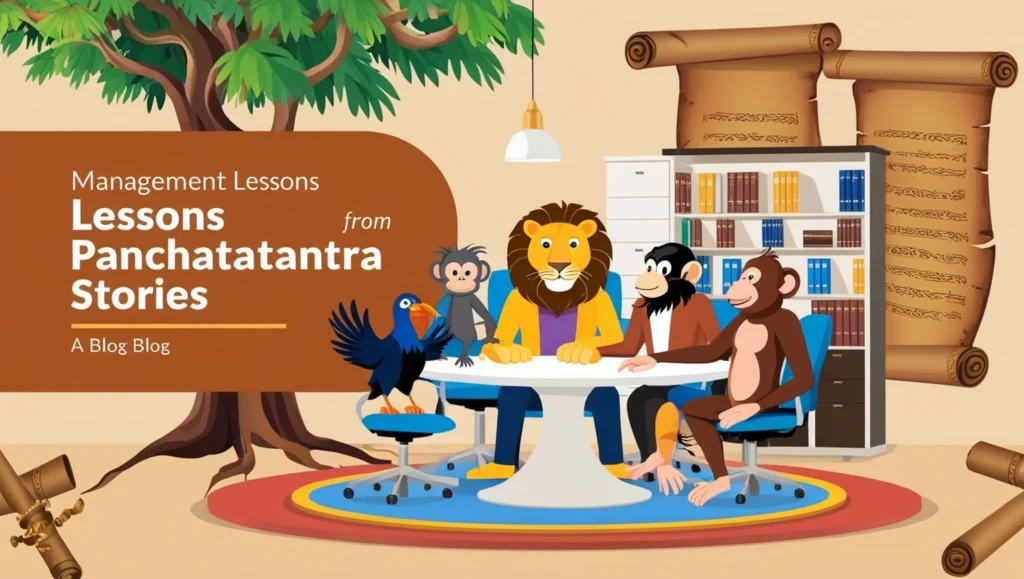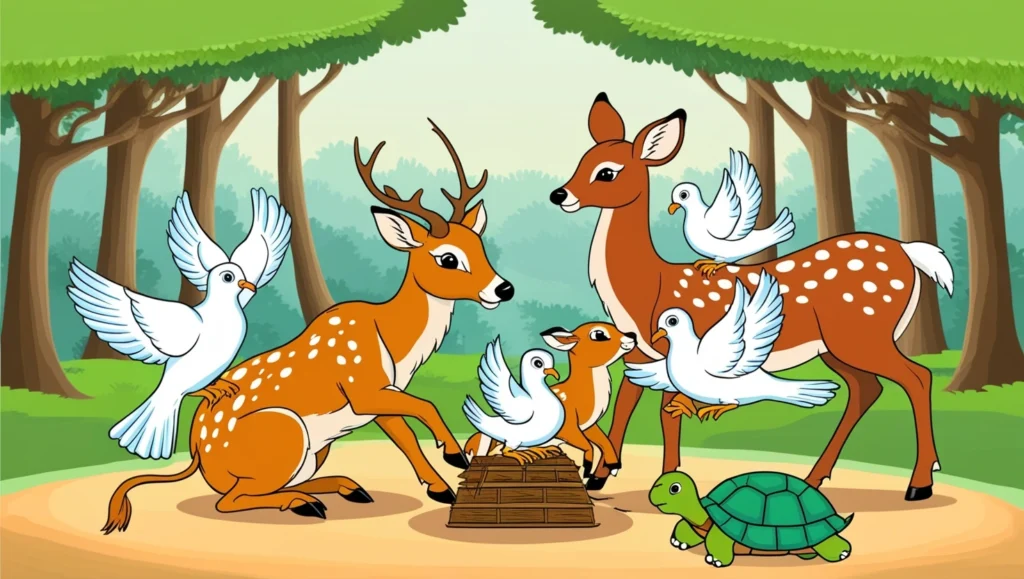The Panchatantra is one of the oldest and most revered collections of stories in Indian literature. Written by Vishnu Sharma, these fables were originally created to teach the princes of an ancient kingdom the essential principles of governance, strategy, and interpersonal skills. Interestingly, the lessons from these stories hold significant relevance for modern management practices as well.
In this blog, we explore timeless management lessons embedded in Panchatantra stories and how they can help leaders, managers, and professionals succeed in today’s complex work environments.

Table of Contents
1. The Value of Collaboration: The Doves and the Net
The Story:
A group of doves gets trapped in a hunter’s net while searching for food. Instead of panicking, the doves decide to work together and fly with the net to escape the trap.
Management Lesson:
Collaboration and teamwork are critical for overcoming challenges. In modern organizations, collective efforts often lead to innovative solutions. Leaders should foster a culture of cooperation, where teams leverage their combined strengths to achieve shared goals.

2. Strategic Planning: The Monkey and the Crocodile
The Story:
A clever monkey befriends a crocodile who plans to kill him to offer his heart to his wife. The monkey, sensing danger, uses his wit and quick thinking to outsmart the crocodile and escape safely.
Management Lesson:
Strategic planning and quick decision-making are key to navigating risky situations. Leaders must anticipate potential threats and craft strategies to turn challenges into opportunities. Staying alert and adaptive is crucial for long-term success.
3. Leadership and Unity: The Lion and the Bull
The Story:
A lion manipulates two bulls into becoming rivals, ensuring they cannot work together and making it easier for him to prey on them individually.
Management Lesson:
A divided team is vulnerable to external threats. Leaders must promote unity and resolve internal conflicts to ensure that teams remain focused on shared objectives. A strong, united workforce is a company’s greatest asset against competition and disruption.
4. The Power of Networking: The Four Friends and the Hunter
The Story:
A deer, a crow, a mouse, and a turtle, who are close friends, work together to escape a hunter’s trap. Each animal uses its unique abilities to save one another, demonstrating the importance of trust and collaboration.
Management Lesson:
Networking and fostering diverse relationships are vital in the corporate world. Just like the animals in the story, each individual in a team brings unique strengths. Effective managers know how to harness these differences to achieve collective success.
5. Risk Management: The Mice and the Cat
The Story:
A group of mice devises a plan to tie a bell around the neck of a dangerous cat so they can hear it approaching. However, none of the mice volunteers to execute the plan.
Management Lesson:
Effective risk management involves not just planning but also executing strategies. Organizations must ensure that plans are actionable and assign clear responsibilities to team members. Merely identifying risks without addressing them leads to failure.
6. Adaptability: The Bird and the Monkey
The Story:
A bird advises a monkey to build a shelter before the rain comes. The monkey ignores the advice and later suffers during the storm.
Management Lesson:
Adaptability and preparedness are critical for long-term success. Managers should anticipate future challenges and proactively prepare for them, rather than reacting to situations after they arise.
Read more:-
Ancient Indian Scriptures: Teaching Kids the Secrets to a Happy Life
Timeless Wisdom from the Bhagavad Gita for Young Minds
बच्चों के लिए भगवद्गीता: सरल भाषा में जीवन के अनमोल पाठ
7. Communication Skills: The Turtle Who Talked Too Much
The Story:
A talkative turtle grabs a stick with his mouth while two swans carry him across a lake. Despite warnings, he opens his mouth to speak and falls to his death.
Management Lesson:
Effective communication is about knowing when to speak and when to listen. Leaders must develop concise and impactful communication skills to ensure their message is clearly understood. Over-communicating or speaking impulsively can lead to misunderstandings or negative outcomes.
8. Negotiation and Diplomacy: The Blue Jackal
The Story:
A jackal accidentally falls into a vat of blue dye and, upon emerging, uses his unusual appearance to declare himself the king of the jungle. Eventually, his true identity is revealed, and the other animals oust him.
Management Lesson:
Authenticity and integrity are vital for effective leadership. While creativity and innovation are important, leaders must avoid deceptive practices. Building trust through honest and transparent communication is the foundation of long-term success in negotiations and relationships.
9. Resource Management: The Crow and the Water Pot
The Story:
A thirsty crow finds a pot with a small amount of water at the bottom. Using stones, the crow cleverly raises the water level to drink it.
Management Lesson:
Resourcefulness is an essential skill in management. Leaders must learn to make the best use of available resources, even in challenging situations. Creativity and innovation can help overcome limitations and achieve objectives.
10. Conflict Resolution: The Two Cats and the Monkey
The Story:
Two cats find a piece of bread and start fighting over it. A monkey offers to mediate and cleverly eats the bread while pretending to divide it equally between the cats.
Management Lesson:
Conflicts within teams can lead to inefficiency and loss of productivity. Managers must act as impartial mediators to resolve disputes and ensure fairness. Allowing conflicts to fester can lead to exploitation by external forces, just as in the story.
The Panchatantra offers a treasure trove of wisdom that resonates deeply with modern management principles. Its stories emphasize collaboration, strategic thinking, adaptability, communication, and ethical leadership—qualities that are indispensable in today’s dynamic corporate environment.
By applying these timeless lessons, managers and leaders can inspire their teams, make better decisions, and create an environment that fosters growth, innovation, and success.
Incorporating such ancient wisdom into contemporary practices not only bridges the gap between tradition and modernity but also adds a human touch to management strategies.
Let these stories guide your professional journey, reminding us that the essence of great leadership lies in simplicity, wisdom, and values.


